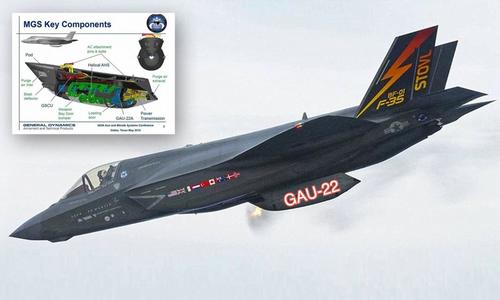US Stealth Jet Accidentally Shot Itself With Armor Piercing Round
A Lockheed Martin F-35B Lightning II sustained millions of dollars in damage last month while flying a routine training mission over U.S. Army Yuma Proving Ground in Yuma, Arizona, when it accidentally shot itself.
Military.com reports the F-35B was on a training mission at Yuma during a night operation when an externally mounted GAU-22 firing 25mm x 137 PGU-32/U SAPHEI-T (semi-armor piercing, high explosive incendiary-tracer rounds) discharged and “exploded after leaving the fighter’s cannon,” Marine Corps spokesman Capt. Andrew Wood confirmed to Military.com on Tuesday.
The aircraft landed safely after the round caused at least $2.5 million in damages.
“It was not immediately clear if the round was fired deliberately. Citing the ongoing investigation, Wood did not provide further details,” said Military.com.
The F-35B is the most advanced fifth-generation fighter jet in the world. This model is particularly designed for the Marines, is capable of short takeoff and vertical landings.
The F-35 program has been plagued with hundreds of issues. For instance, the 25mm gun on the stealth jet has had an accuracy problem hitting ground targets.
Robert Behler, the Pentagon’s independent weapons tester, told Bloomberg in January that the F-35 has 871 software and hardware flaws that could affect combat operations.
Here are other unresolved glitches of the F-35 program (the partial list via Defense News):
- When the F-35B vertically lands on very hot days, older engines may be unable to produce the required thrust to keep the jet airborne, resulting in a hard landing.
- After doing certain maneuvers, F-35B and F-35C pilots are not always able to completely control the aircraft’s pitch, roll and yaw.
- Supersonic flight in excess of Mach 1.2 can cause structural damage and blistering to the stealth coating of the F-35B and F-35C.
- Cabin pressure spikes in the cockpit of the F-35 have been known to cause barotrauma, the word given to extreme ear and sinus pain.
- The spare parts inventory shown by the F-35’s logistics system does not always reflect reality, causing occasional mission cancellations.
- If the F-35A and F-35B blows a tire upon landing, the impact could also take out both hydraulic lines and pose a loss-of-aircraft risk.
- Possible maneuvering issues when the aircraft is operating above a 20-degree angle of attack.
- The F-35’s logistics system currently has no way for foreign F-35 operators to keep their secret data from being sent to the United States.
It could take billions of dollars more over the next few years for upgrades, research and development, aircraft procurement, operations, and maintenance to resolve these issues.
The F-35 is America’s most expensive jet fighter program, expected to cost taxpayers $1 trillion over the years. The latest snafu is more evidence that the world’s most advanced stealth fighter is plagued with flaws – suggesting it may not be combat-ready.
Tyler Durden
Thu, 03/25/2021 – 21:20![]()
Zero Hedge’s mission is to widen the scope of financial, economic and political information available to the professional investing public, to skeptically examine and, where necessary, attack the flaccid institution that financial journalism has become, to liberate oppressed knowledge, to provide analysis uninhibited by political constraint and to facilitate information’s unending quest for freedom. Visit https://www.zerohedge.com
